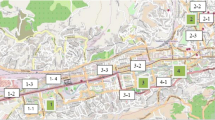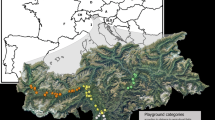Abstract
Pesticide pollution in Sarajevo public playgrounds is an important health and environmental issue, and the lack of information about it is causing concerns amongst the general population as well as researchers. Since children are in direct contact with surface soils on children’s playgrounds, such soils should be much more carefully examined. Furthermore, herbicides and pesticides get transmitted from soil surfaces brought from outside the urban areas, or they get dispersed following their direct applications in urban areas. Infants’ and children’s health can be directly affected by polluted soils because of the inherent toxicity and widespread use of the different pesticides in urban environments such as playgrounds. In addition to that, the presence of chromated copper arsenate (CCA) wood preservative pesticide found as soil pollutant in playing equipment was also documented. Soil samples from playgrounds were collected and analyzed for triazines, carbamates, dithiocarbamates, phenolic herbicides and organochlorine pesticides. Samples for the determination of heavy metals Cu, Cr and As were prepared by microwave-assisted acid digestion, and the findings were determined by using an inductively coupled plasma optical emission spectrometer. Triazines, carbamates, dithiocarbamates, chlorphenoxy compounds, phenolic herbicides, organochlorine pesticides and organotin compounds were detected in playground soils and their determined concentrations (mg/kg) were respectively found as follows: <0.005, <0.05, <0.5, < 0.4, <0.1, <0.001 and <0.004. The determined contents (mg/kg) of Cu, Cr and As were in the ranges from 16.77 to 80.21, from 7.14 to 15.45 and from 3.31 to 4.43, respectively. Our preliminary results raise concerns about potential adverse effects of herbicides and pesticides on human health, which strengthens the case for a more preventative and protective approach to the uncontrolled presence of herbicides and pesticides in Sarajevo’s playground soils.

Similar content being viewed by others
References
Arias-Estevez, M., Lopez-Periago, E., Martinez-Carballo, E., Simal-Gandara, J., Mejuto, J. C., & Garcia-Rio, L. (2008). The mobility and degradation of pesticides in soils and the pollution of groundwater resources. Agriculture Ecosystems and Environment, 123, 247–260.
Barraj, L. M., Tsuji, J. S., & Scrafford, C. G. (2007). The SHEDS-Wood model: incorporation of observational data to estimate exposure to arsenic for children playing on CCA-treated wood structures. Environmental Health Perspectives, 115(5), 781–786.
COM. (2006). Communication from the Commission to the Council, the European Parliament, the European Economic and Social Committee and the Committee of the Regions. A Thematic Strategy on the Sustainable Use of Pesticides. Commission of the European Communiti.
Dagnac, T., Jeannot, R. (2005). Herbicide residues in the environment. In Leo M.L. Nollet (Ed.), Chromatographic Analysis of the Environment, Third Edition (pp. 976–1000). CRC Press.
Glorennec, P., Lucas, J. P., Mandin, C., & Le Bot, B. (2012). French children’s exposure to metals via ingestion of indoor dust, outdoor playground dust and soil: contamination data. Environmental International, 45, 129–134.
Gustafson, D. I. (1989). Groundwater ubiquity score: a simple method for assessing pesticide leachability. Hazard assessment. Environmental Toxicology and Chemistry, 8(4), 339–357.
Harrison, R. (2003). CCA pressure-treated wood and playground structures: an overview of the scientific information on health risk. Canadian Institute of Treated Wood.
Hawley, E. L., Kresic, N., Wright, A. P., & Kavanaugh, M. C. (2009). Assessing the current and future impacts of the disposal of chromated copper arsenate-treated wood in unlined landfills. Journal of the Air & Waste Management Association, 59, 332–342.
Hodgson, E. (2004). A textbook of modern toxicology (3rd ed.). North Carolina: Wiley-Interscience.
Imperato, M., Adamo, P., Naimo, D., Arienzo, M., Stanzione, D., & Violante, P. (2003). Spatial distribution of heavy metals in urban soils of Naples city (Italy). Environmental Pollution, 124(2), 247–256.
Jiang, Y. F., Wang, X. T., Sun, Y. Z., Wang, F., Wu, M. H., Sheng, G. Y., & Fu, J. M. (2010). Residues of organochlorine pesticides in urban soil of Shanghai. Huan Jing Ke Xue, 31(2), 409–414.
Kwon, E., Zhang, H., Wang, Z., Jhangri, G., Lu, X., Fok, N., Gabos, S., Li, X., & Le, X. (2004). Arsenic on the hands of children after playing in playgrounds. Environmental Health Perspectives, 112(14), 1375–1380.
Lammel, G., Klanova, J., Eric, L., Kohoutec, J., & Kovacic, I. (2011). Sources of organochlorine pesticides in air in an urban Mediterranian environment: volatilization from soil. Journal of Environmental Monitoring, 13(12), 3358–3364.
Mott, L. (1997). Our children at risk: the 5 worst environmental threats to their health. Natural Resources Defense Council.
Novak, J., Giesy, J. P., Klanova, J., & Hilcherova, K. (2013). In vitro effects of pollutants from particulate and volatile fractions of air samples—day and night variability. Environmental Science and Pollution Research, 20, 6620–6627.
Popoola, O. E., Bamgbose, O., Okonkwo, O. J., Arowolo, T. A., Odukoya, O., & Popoola, A. O. (2012). Heavy metals content in playground topsoil of some public primary schools in Metropolitan Lagos, Nigeria. Research Journal of Environmental and Earth Sciences, 4(4), 434–439.
Pradhan, A., Markande, S. K., & Kurre, R. K. (2014). Evaluation of impact of pesticides on the basis of their physico-chemical properties. Journal of Industrial Pollution Control, 30(2), 223–226.
Puskas, I., Farsang, A., Csepe, Z., & Bartus, M. (2014). Heavy metal exposure and risk characterization of top soils in urban playgrounds and parks (Hungary). Geophysical Research Abstracts, 16, 641.
Roots, O., Roose, A., Kull, A., Holoubek, I., Cupr, P., & Klanova, J. (2010). Distribution pattern of PCBs, HCB and PCB using passive air and soil sampling in Estonia. Environmental Science and Pollution Research International, 17(3), 740–749.
Sapcanin, A., Cakal, M., Jacimovic, Z., Pehlic, E., & Jancan, G. (2016). Soil pollution fingerprints of children playgrounds in Sarajevo city, Bosnia and Herzegovina. Environmental Science and Pollution Research. doi:10.1007/s11356-016-6301-5.
Towsend, T., Solo-Gabriele, H. (2006). Environmental Impacts of Treated Wood. CRC Taylor & Francis Group.
Tuzimski, T. (2012). Pesticide residues in the environment. In Hamir S. Ratore and Leo M.L. Nollet (Ed.), Pesticides:Evaluations of Environmental Pollution (pp. 150–155). CRC Press.
US EPA. (2003). A probabilistic Exposure Assessment for children who contact CCA treated playsets and decks. Using the stochastic human exposure and dose simulation model for the wood preservative scenario (SHEDS-WOOD). Environmental Protection Agency.
Vinson, F., Merhi, M., Baldi, I., Raynal, H., & Gamet-Payrastre, L. (2011). Exposure to pesticides and risk of childhood cancer: a meta-analysis of recent epidemiological studies. Occupational & Environmental Medicine, 68(9), 694–702.
Wu, Q., Leung, J., Yuan, X., Huang, X., Li, H., Huang, Z., & Li, Y. (2015). Biological risk, source and pollution history of organochlorine pesticides (OCPs) in the sediment in Nansha mangrove, South China. Marine Polllution Bulletin, 96, 57–64.
Zacharia, J.T. (2011). Identity, physical and chemical properties of pesticides. In Stoytcheva M. (Ed.) Pesticides in the Modern World -Trends in Pesticides Analysis (pp. 10–14). In Tech. doi: 10.5772/17513.
Author information
Authors and Affiliations
Corresponding author
Rights and permissions
About this article
Cite this article
Sapcanin, A., Cakal, M., Imamovic, B. et al. Herbicide and pesticide occurrence in the soils of children’s playgrounds in Sarajevo, Bosnia and Herzegovina. Environ Monit Assess 188, 450 (2016). https://doi.org/10.1007/s10661-016-5463-4
Received:
Accepted:
Published:
DOI: https://doi.org/10.1007/s10661-016-5463-4




